An aesthetic awareness has been a part of Leslie Baum’s life experience since her youth. Through consistently researching the art and culture encountered in these early rendezvous and holding an understanding of universal tenets that recur in art, Baum produces subtle meditative works and installations that initially appear aligned solely with early Modernist’s investigations. However, upon further inspection one will locate observation that identifies her thoughtful artistic investigations informed by art of the 20th c., but clearly of the present. This week the COMP Magazine caught up with Baum at her South Austin studio to discuss her lifelong connection to the arts, her various recent exhibitions, the use of recurring forms that appear to be portals, her fascination with early 20th c. painters like Sonia Delaunay, and what’s the plan for the new year.
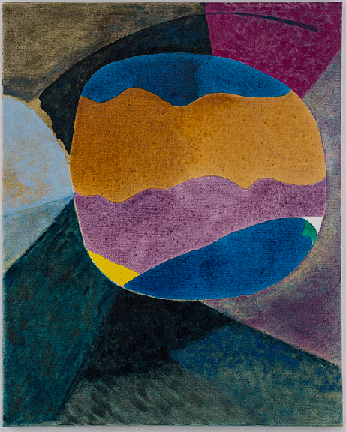
Leslie Baum, shape of the day: h.f,f.p., 20” x 16”,
oil and acrylic on canvas, 2018
I’m fascinated with our longtime overlap in terms of interacting with the art and photography community here in Chicago. Having worked at the MoCP (Museum of Contemporary Photography), I recall your parents. They were highly motivated photography supporters and dealers. I believe a scholarship for the study of photography was initiated by your family at Columbia College Chicago? Can you describe the role art and photography played in your youth? Can you share any early experiences?
I grew up with parents who were both makers and art enthusiasts. My mom was a Sunday painter. She made watercolors and ceramics. She was also a docent at the High Museum of Art. Although my dad was a career IBMer, he was also a life long amateur photographer. There was a darkroom in each house that I lived in. Every time we road tripped as a family, we would always take back roads, with my dad stopping at various small towns along the way to chat up local characters and take their portraits. As a child I found this totally annoying. However hindsight being 20/20, it was an important up close example of an artist at work. My earliest years were in Summit, New Jersey, a bedroom community of New York City. We would go into the city most weekends, visiting the Met and MOMA. My dad would buy supplies at the photo stores. I feel profoundly lucky to have come up in a household that loved art and that made art too. I have a rush of early childhood memories, of making and of visiting art museums, of being in my dad‘s dark room under the glow of the safety lights with the smell of chemicals, and of spending time in the pottery studio where my mom took classes. The time spent at the High Museum is especially meaningful, wandering the galleries, for hours unsupervised when my mom was volunteering. It was the 1970s after all.
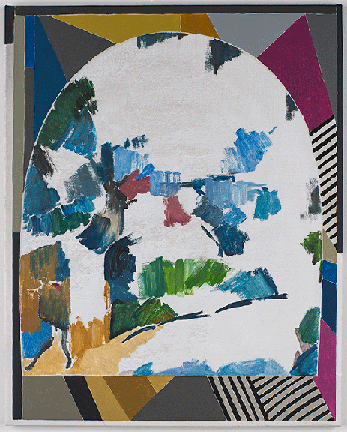
Leslie Baum, shape of the day: p.c, s.d, 20” x 16”,
oil and acrylic on canvas, 2017
You consider some paintings you encountered in your youth as family. Can you elaborate on this observation?
I spent a lot of time in art museums. In early childhood, these were primarily the Met and MOMA. Once we moved to Atlanta I spent countless hours in the galleries of the High Museum. This was as a young child and as a teen. Most of my close family lived in the DC area. When we visited them, we often went to the various National Galleries. It comes as little surprise really that I work in a museum. I am a 20+ year veteran of education department, now called Learning and public Engagement, at the Art Institute of Chicago. When I say that I feel that many of the paintings and painters whom I reference and sample in my own work are like family, I mean it very earnestly. I grew up with them. They are familiar, my familiars. I see some of these works at holidays, when visiting museums in other cities and others on a daily basis with my ongoing employment at AIC.
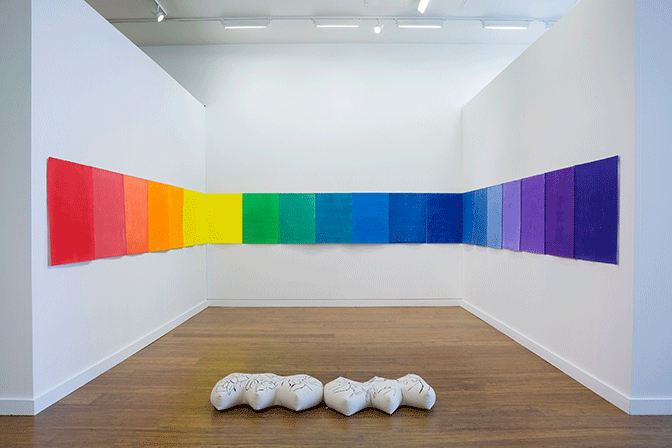
Leslie Baum, here comes the rainbow, installation view, echoes,
acrylic on embossed paper, window seats, acrylic on canvas filled with buckwheat hulls, 2017
Perhaps, you can share with us your intent and comment upon the interrelationship with production for the work “here comes the rainbow” (2016)?
Here Comes the Rainbow was in important show for me. It was the first time I had a year to plan an exhibition for a large space and for which I received true support. This offered me the opportunity to think through the work and consider how it would function together as a singular exhibition. The concept of the show grew out of an act of generosity. This was an invitation about a year before by Stan Shellenbarger to make prints with him at Spudnik press. Stan is a patient presence, especially since my initial reaction to print making was just how much I just wanted to run to my studio and paint instead. The process was too methodical for my nature. With these thoughts in mind, I decided to forgo the ink altogether and make embossings. I had been working in the studio with a series of shapes and I brought seven of those shapes, as canvas cut-outs, to the press. Seven seemed like a good number, with metaphorical potential, such as the days of the week or colors in the spectrum. I cut these shapes out of canvas and embossed them under great pressure with the guidance of Stan into the paper. Back in my studio, I painted them, creating subtle monochromes, where the embossed image would only reveal it self in proximity and become more compelling with close looking. It became evident to me early on that each shape would correlate with a color in the spectrum. The Cleve Carney show grew out of this body of work. I knew that I wanted to hang these pieces flush, side by side, in an Ellsworth Kelly inspired installation. I was excited to then translate these shapes across various other media and scales. The largest being cutouts of unstretched canvas and painted, as tall as 12 feet. I also made a series of the shapes in stoneware. I installed this ceramic piece on a narrow canvas wrapped shelf. All the ceramic panels have a meaningful front and a back. The front sides are glazed various whites and the backside are pray-painted the colors of the spectrum, with the vibrant color reflecting off the wall and casting an aura or glow. The piece is called white light. I saw all of this work as being hopeful, as a respite from the current tense political times, as a calm place to sit and be. And sitting and being was built into the work with an additional series called window seats. The window seats are paintings and they are meditation pillows. Each of these window seats were placed on the floor and were available for the public to engage with. They were intended to be sat on and touched. They are meant for intimacy. Each pillow is shaped, each is one of the seven shapes and they were placed around the exhibition. During the run of the show, once a week guided meditations were offered in the gallery.
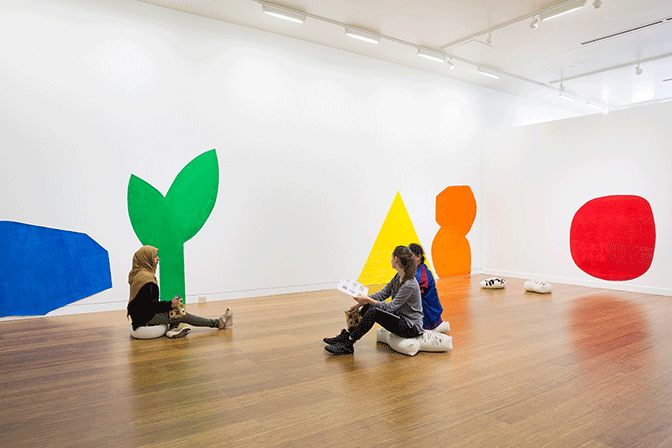
Leslie Baum, here comes the rainbow, install view, rabbit holes and window seats, acrylic paint on canvas, 2017
Lets discuss “excuse me if I get to deep…” (2016) This series of work consists of paintings and ceramic works that were organized into an installation. The works are formally beautiful, employ recognizable, yet abstract forms, and require meditation. The title implies depth? Can you discuss the items produced in relationship to the title you have assigned?
For this exhibition I wanted to unify the disparate materials and processes that I had been exploring in the studio. I organized the exhibition around a mystical story from the Kabbalah. This story is a creation story with metaphorical heft and power. It felt urgent for me to use this story as a lens to look at and make sense of my painting practice. The story organized my thoughts and helped me delve deeper into understanding how and why I was employing images and images fragments from art history. Also I felt like it was time to share in a clear and public way that I am a painter who invests her work with a spiritual dimension. Owning this truth was vulnerable making. It’s funny because it was only a little over two years ago and I feel like a lot has changed since then. Framing your work in the context of a mystical creation story no longer feels so out-on-a-limb, but it really did feel like it at the time. This urge to go deep informed the title of the show, which is a quote from a Lauren Hill song. I wrote the exhibition essay. I knew that it needed to be a personal statement. As a not very confident writer, this was also a challenging thing for me to do! Here is how I tell the retell the Kabbalah creation story in that essay.
In the beginning God‘s presence filled the universe. God drew in God‘s breath contracting into an infinitesimal point. There was darkness, and then space was created by God absence, it was a space bigger than imagination and ready to be filled with creation. Holy vessels came into being and God poured divine light into them. The light was so pure and powerful that it shattered the vessels and sparks of holy light fused into each broken fragment. The shards, imbued with divine light, scattered, fell, and became entangled into the newly created world. Matter and spirit merged. Material and purpose entwined. Object and essence united.
I love this creation story for its ability to condense the sheer magnitude of truly big ideas into a poetic form. This story is from the 16th century and yet it speaks to current scientific understanding of the creation of the universe. It also suggests that matter is holy, that the material of art, even lowly canvas and clay have a sacred dimension. This exhibition was an opportunity for me to make objects that asked questions like can a painting become a passageway to somewhere else like a rabbit hole in an old Bugs Bunny cartoon and can gathering up and remaking images from art history be a redemptive act.
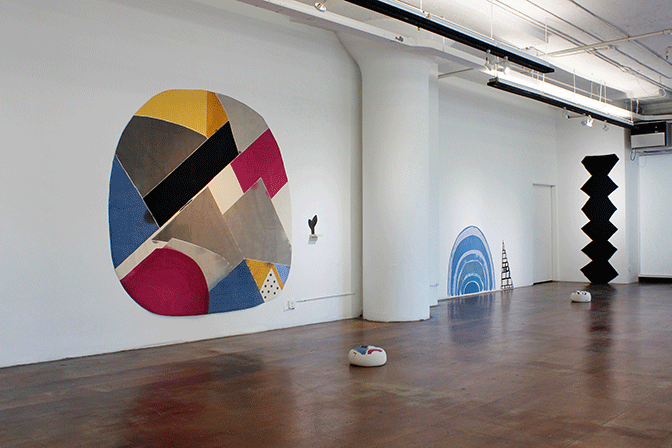
Leslie Baum, excuse me if i get too deep, installation view, Geary, 2016
Throughout your work I see recurring forms. For instance, I see portals to be a common visual device. Can you discuss the use of these elements? What do you see these elements conveying within your oeuvre?
The portal is a very productive and meaningful formal device for me. It helps convey what I understand about being in the world. That it is not a singular experience but rather a multidimensional one, that we often are at two places at once: in our minds and memories and where we physically are. All is not as it looks either. There are mysterious depths and worlds within worlds. This can be as straightforward as how reading a story can move you into a new realm or as esoteric as the possibilities suggested by multiple realities. Formally the portal it is very satisfying structure, opening up pictorial space and inviting discovery. It is a device through which I learn more about the language of paint and painting itself.
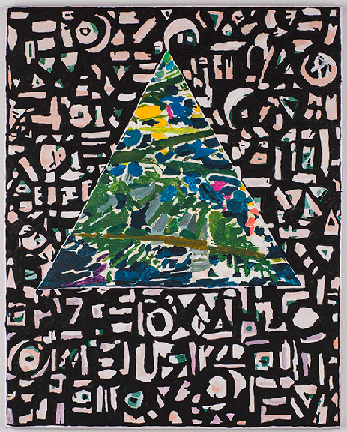
Leslie Baum, shape of the day: h.f,f.p., 20” x 16”,
oil and acrylic on canvas, 2018
The history of painting has been a consummate throughout your practice. You hold the 20th century artist Ukranian-born French artist, Sonia Delauney, in high regard. I see visual connections to this precedent. Can you speak to this?
There are many 20th c. artists who are important to me and whose work informs my paintings. Sonia Delaunay certainly stands out for her generous interdisciplinary thinking, poetic practice, her textile designs, her collaborations with poets. Her paintings, textiles, and set designs are all equally compelling works. She did not have a hierarchal view of making and valued all her creative endeavors. I admire and aspire toward that approach. Moreover her sense of color and design remains my high bar. Another exemplary artist for me is Alma Thomas. I look to her and her paintings for guidance. Her work reminds me of the joy to be found in responding to natural phenomena and the possibilities of expressing what is seen and felt in an abstract and painterly language. The generous optimism of her paintings and her work’s dialogue with science, nature, and awe are a hopeful reminder of what painting can do and be.
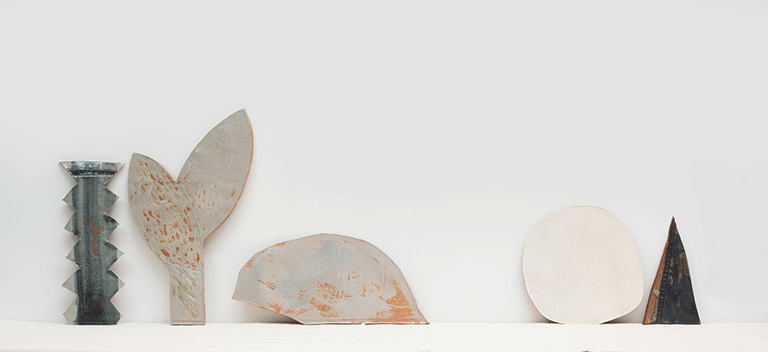
Leslie Baum, this&that: moonlight, sizes variable, mason stain, glaze and spray paint on stoneware, 2016
What do you value most in your aesthetic practice?
I love exhibition making. The specifics of a space, gallery or otherwise, present a productive structure for reconsidering how my work operates outside the studio. Additionally, making a show pushes me to bring together disparate elements of my work into a unified statement. A good example is the upcoming group show Rebuilding the Present, curated by Holly Cahill at the Weinberg/Newton Gallery. Holly invited me to make a meditation room for the exhibition. This opportunity is exciting and is what I love most about making and exhibiting work. I am re-showing work from last year: a set of meditation pillows that were part of the installation at the Cleve Carney Gallery. Re-contextualizing older work, in this case only a year and a half old, is meaningful. Placing work made for one exhibit into another is how I learn that the paintings aren’t static and they are, in a way, living things, that continue to change and evolve. As I change, I come to understand and perceive the works anew. Also with time and shifting contexts, the paintings themselves do not stay the same. They evolve. The set of meditation pillows or window seats will be in a much more intimate space than the one that I made them for. They will be in closer proximity to each other. The room will be a deep grey, painted walls and a carpeted floor. Additionally I am making an 8ft in diameter unstretched painting, that I call a rabbit hole. It will go nearly from floor to ceiling. I’m eager to see how the pillows and the new piece come together. I also hope to include a small 16 x 20 painting that I will hang low. It will be at eye level, if you are sitting on one of the meditation pillows. Another artist participating in the exhibit, Meredith Haggerty, has made an audio piece, a guided meditations to be used with the installation. I am looking forward to experiencing how the window seats, made for a different exhibition, and the new work come together in this particular small gallery. I am even more curious to discover how the installation will be experienced and engaged with by visitors to the show.
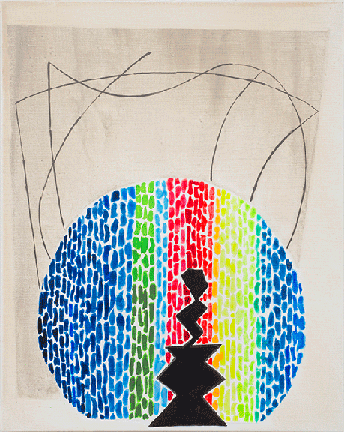
Leslie Baum, shape of the day: at, b.n,s.d., 20” x16”,
oil and acrylic on canvas, 2016, (from excuse me if i get too deep)
For additional information on the aesthetic practice of Leslie Baum, please visit:
Leslie Baum – https://www.lesliebaum.net/
Cleve Carney Art Gallery – http://www.clevecarneygallery.org/leslie-baum/
Hyperallergic – https://hyperallergic.com/120927/weekend-studio-visit-leslie-baum-in-logan-square-chicago/
Inside/Within – http://insidewithin.com/leslie-baum/
Youtube (here comes the rainbow) – https://www.youtube.com/watch?v=euzB9HDTgWw
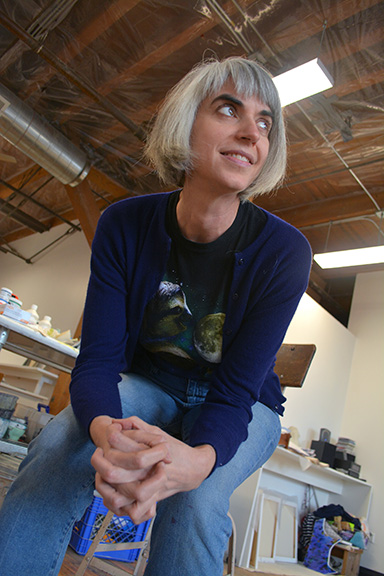
Leslie Baum, artist, Chicago, 2018
Artist interview and portrait by Chester Alamo-Costello


